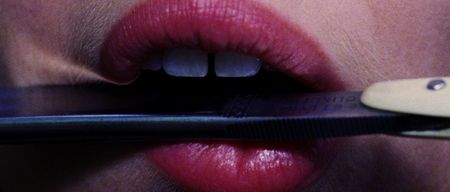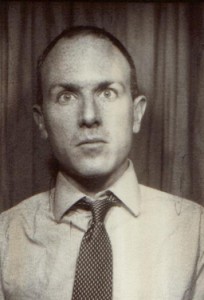Marilyn Johnson recently appeared on The Bat Segundo Show #324. Ms. Johnson is most recently the author of This Book is Overdue!

Condition of Mr. Segundo: Hoping to avoid being arrested by Rusty the Bailiff.
Author: Marlyn Johnson
Subjects Discussed: Why libraries are little regarded by the American public, the preservation of blogs and websites, Josh Greenberg’s efforts at digital preservation, the Firefox extension Zotero, the rickroll video’s removal from YouTube, the Barnard Zine Collection, the reliance upon private entities to preserve information, the lone guy archiving Hunter S. Thompson’s early articles, the French government’s commitment to preserving culture vs. Google, Jessamyn West’s Ubuntu video and copyright problems, the inability for Joseph V. Hamburger’s archives to find a library, a writer’s responsibility to preserve their writing, Salman Rushdie’s digital manuscripts, commenters and obituaries, dead people writing obituaries, the mutability of text, future generations of computer users and libraries, inflatable humans vs. librarians, the New York Public Library consolidation and permanent closing of the Shiochi Noma Reading Room, specialist libraries vs. public libraries, the American Kennel Club Library, librarians within Second Life, vital specialists vs. unpaid volunteer librarians, shaky wifi connections and libraries, the need for out-of-work and underemployed librarians to have online identities, Twitter as a questionable source for librarians, strange construction workers who attempt to hijack the conversation between the Correspondent and Ms. Johnson, street librarians, Radical Reference and whether it provides services those who don’t question authority, and whether the efforts made by the librarians opposing the Patriot Act have fallen short due to harsher prison terms for those hanging helpful signs.
EXCERPT FROM SHOW:
 Johnson: The Internet is in the library. Google is in the library. The librarians know how to use that. So you go to those public computers in the library. You have a librarian who can not only do Google, but who can also tell you, point you to any number of other resources that are not included in Google, or that are very difficult to get to through Google. It seems like Google is so simple. “It’s so simple even your grandmother can use it,” is the way it was described to me. Yeah, it’s brilliant for getting the quick hit on the restaurant in the Village that you want to have dinner at. There’s the address. There’s the phone number. There’s the little Google map that will get you there. But when you are actually trying to track back. When I have a clipping of a newspaper, and I’m trying to find the digital version of that, I get lost sometimes. It can’t find it. The bread crumbs don’t take you to where you know it has to be. And I’ve had librarians who have actually shown me how to wend my way through Google, which is, after all, full of redundancies, not weighted in terms of date. You need to put your heavy boots on to wade through it sometimes.
Johnson: The Internet is in the library. Google is in the library. The librarians know how to use that. So you go to those public computers in the library. You have a librarian who can not only do Google, but who can also tell you, point you to any number of other resources that are not included in Google, or that are very difficult to get to through Google. It seems like Google is so simple. “It’s so simple even your grandmother can use it,” is the way it was described to me. Yeah, it’s brilliant for getting the quick hit on the restaurant in the Village that you want to have dinner at. There’s the address. There’s the phone number. There’s the little Google map that will get you there. But when you are actually trying to track back. When I have a clipping of a newspaper, and I’m trying to find the digital version of that, I get lost sometimes. It can’t find it. The bread crumbs don’t take you to where you know it has to be. And I’ve had librarians who have actually shown me how to wend my way through Google, which is, after all, full of redundancies, not weighted in terms of date. You need to put your heavy boots on to wade through it sometimes.
Correspondent: But then again, we are seeing various developments along the lines of what we were mentioning earlier about the mutability of text.
Johnson: Yes.
Correspondent: The Semantic Web, which I can probably go into.
Johnson: Blah blah blah. Yeah, we could go on all night.
Correspondent: Yeah. But to shift it to libraries, are the advantages essentially these informed people, the aspect of physical space, and the aspect of real-life interaction? As opposed to online interaction? Do you think that these elements are strong enough to endure whatever technological developments are emerging in the next four decades?
Johnson: Okay, I’m zipping around the Internet like crazy. I’m not unsavvy. I’ve bent a few corners. I’ve been to the few corners of the Web. I make a telephone call and if there are seven options — the automated answering service that tries to funnel me down one little hall, as opposed to another — I never fit in the categories. I’m never Option 1 through 7. Would you like to hear these options again? I freak out. I go crazy. I need the human. I need the human to help explain it to me. I need the human to help me know what I missed. I need the human to help me phrase the question. And I don’t think humans are ever going to go out of style. Call me crazy.
Correspondent: Yeah. Until, of course, the inflatable human arrives.
Johnson: No, no. You need the librarian. You need the librarian!
Correspondent: The recent New York Public Library consolidation caused the Shiochi Noma Reading Room to be permanently closed on September 8, 2008. You talked with John Lindquist, the former director of this Asian and Middle Eastern Reading Rooms, now curator, who pointed out that his staff had been halved, When the Arabic-language cataloger retires, the library will be without an Arabic-language librarian. So this closing is particularly ironic, given that, in 1997, more than a million dollars were poured into this room to refurbish it and to make it spruced up and the like. So if specialized knowledge like this is so fleeting, if something recently renovated only ten years before is going to be thrown out the window, is it safe to say that the generalists are winning this internecine war within the libraries?
Johnson: They have a really interesting challenge. The New York Public Library. And they’re galloping forward. They’re really trying to take a research institution and preserve as much of the research in it as possible, and also make it a much more tourist-friendly place. People don’t understand that when they come to the library, it is a research institution. That you don’t check things out. So the New York Public Library — the Board — has decided, and the librarians — the chief librarians — that they’ll have a children’s center in the basement there. And they will circulate the books there. And they want more regular users to come to this beautiful building. They want to open it up more. So all of those treasures from the Middle East are there. They’re there. The librarians who administer them and who work with the scholars are not. They seem to be going away. And now John Lundquist has gone away. And this room went away, not because they didn’t like the room or they didn’t like what it stood for, but because it happens to be on a central hall that’s going to provide access for what will now be circulating parts of the library. They took this research library and are melding it with the circulating library. So in the course of making it friendly to people who want to just come and check out a DVD, they’ve had to squeeze some of the other stuff into different places. And those librarian positions that are very scholarly and very specialized, when they come up for retirement, they are not replacing those librarians. They’re putting it into people who can work with the ordinary office/street library user.
Correspondent: Those librarians are part of this big squeeze. So, therefore, will we have to turn to more specialist libraries, such as the American Kennel Club library, which you investigated, or will the onus fall upon universities to pick up the specialized slack?
Johnson: Well, you want to hear a tragic story? I went to the American Kennel Club library. And that librarian is no longer there.
Correspondent: Really?
Johnson: And you know why? Because they’re running out of money. And where are they going to cut it? Where are they going to cut funds? So the librarian is no longer working there. You can go there. There’s an archivist. There are people who work for the American Kennel Club magazine. All the information is still there. All the material. The beautiful skeleton of the old dog looking over the reading tables is still there. But if you want to find something, you’re going to be taking out a flashlight and looking around. It’s just heartbreaking to me. These are really tough times. To lose the human being who is the guide to all this information, and often the architect. Who put it all together. It’s craziness. And we are losing something so valuable right now. This book is overdue, and I wish it had come out last year. Before ever so many of these cuts had been instituted.
Correspondent: So it seems to me that the generalists are winning the war against the specialists. But you do bring up things such as the Second Life librarian. And the scenario there is that it’s largely based up of volunteers. But if you’re relying on volunteers and you’re not relying on compensation, then how can you have enough of a buffer to replace these vital specialists? And not only that, but if a librarian is essentially a persona — a metaphor, if you will — then does that necessarily replace the real thing? Is it something of a ruse? More of a sort of fantasy than a duty to the public?
Johnson: Wow, we’re going to go down some labyrinths here. You know, what’s interesting about Second Life is that there are bona-fide librarians who are out there, in their spare time, doing research and development in the field. Like saying, here’s a really interesting wonky kind of thing that we can do. Let’s see if we can adapt library science to it. And, in fact, when you think about it, any population that you can think of can use a librarian to help it. This brilliant Radical Reference librarians, who said “Street protesters in great numbers coming to New York, a place that does not have public toilets. Let’s go serve up some information. Let’s go make ourselves available. And if they need us, they can ask us hard questions and we’ll do our best to find true answers for them.” You know, combat rumors. Help them navigate the streets, some of which will be closed. In Second Life, they’re saying, “Oh my goodness. Here’s this exciting, cool, weird place. Virtual reality on the Internet.” And anybody can access it by downloading the free software. And you create a little avatar and you go into this world. “I bet they need librarians.” And in fact, they do. Why? Because ever so many little corners of this world are created by the people who go on Second Life as recreations of a time in history. For instance, there’s a Renaissance island that has a replica of Shakespeare’s — what do you call it, the theater.
Correspondent: The Globe, yeah.
Johnson: Yeah. There is a Harlem Renaissance world that recreates the 1920s. And so librarians are there doing all this research to help make that world accurate. They’re saying, “This is what fashion looked like. These are what cars looked like. Yes, this existed during that time. This didn’t. This was how a joust went. This is what a lady would wear in her hair.” And these kinds of factual historic questions, librarians are ideally suited to answer them.
Correspondent: On the other hand, when you tried to contact J.J. Drinkwater and these other folks, you had your wifi connection cut out on you. So this leads me to wonder…
Johnson: What?
Correspondent: You mention this in the book.
Johnson: Okay.
Correspondent: That you were trying to interview the Second Life librarians and that you were doing this in a library in your laptop.
Johnson: Oh my goodness.
Correspondent: And the wifi cut out. So this leads me to wonder…
Johnson: Yes.
Correspondent: The real thing, which is not going to cut out. At least I would hope that someone would not dissolve before my eyes. Second Life is not exactly the best substitute for that.
The Bat Segundo Show #324: Marilyn Johnson (Download MP3)
This text will be replaced
Listen: Play in new window | Download


 This correspondent contacted Mr. Stein in an effort to determine answers to some of these questions, putting forth a number of inquiries concerning the Paris Review hiring process, whether or not Mr. Stein felt that he clinched the job during that vital first interview (thus following the advice often found on career-oriented websites), the degree to which Mr. Stein planned to break from or carry on Philip Gourevitch’s legacy, whether or not there was any hazing ritual involved in getting the new job, and what will happen to the authors whom Mr. Stein has edited at FSG. On these vital points, Mr. Stein insisted that he had “no good answers.” But he was generous enough to provide a few answers to other questions. The results can be found below.
This correspondent contacted Mr. Stein in an effort to determine answers to some of these questions, putting forth a number of inquiries concerning the Paris Review hiring process, whether or not Mr. Stein felt that he clinched the job during that vital first interview (thus following the advice often found on career-oriented websites), the degree to which Mr. Stein planned to break from or carry on Philip Gourevitch’s legacy, whether or not there was any hazing ritual involved in getting the new job, and what will happen to the authors whom Mr. Stein has edited at FSG. On these vital points, Mr. Stein insisted that he had “no good answers.” But he was generous enough to provide a few answers to other questions. The results can be found below.
 Johnson: The Internet is in the library. Google is in the library. The librarians know how to use that. So you go to those public computers in the library. You have a librarian who can not only do Google, but who can also tell you, point you to any number of other resources that are not included in Google, or that are very difficult to get to through Google. It seems like Google is so simple. “It’s so simple even your grandmother can use it,” is the way it was described to me. Yeah, it’s brilliant for getting the quick hit on the restaurant in the Village that you want to have dinner at. There’s the address. There’s the phone number. There’s the little Google map that will get you there. But when you are actually trying to track back. When I have a clipping of a newspaper, and I’m trying to find the digital version of that, I get lost sometimes. It can’t find it. The bread crumbs don’t take you to where you know it has to be. And I’ve had librarians who have actually shown me how to wend my way through Google, which is, after all, full of redundancies, not weighted in terms of date. You need to put your heavy boots on to wade through it sometimes.
Johnson: The Internet is in the library. Google is in the library. The librarians know how to use that. So you go to those public computers in the library. You have a librarian who can not only do Google, but who can also tell you, point you to any number of other resources that are not included in Google, or that are very difficult to get to through Google. It seems like Google is so simple. “It’s so simple even your grandmother can use it,” is the way it was described to me. Yeah, it’s brilliant for getting the quick hit on the restaurant in the Village that you want to have dinner at. There’s the address. There’s the phone number. There’s the little Google map that will get you there. But when you are actually trying to track back. When I have a clipping of a newspaper, and I’m trying to find the digital version of that, I get lost sometimes. It can’t find it. The bread crumbs don’t take you to where you know it has to be. And I’ve had librarians who have actually shown me how to wend my way through Google, which is, after all, full of redundancies, not weighted in terms of date. You need to put your heavy boots on to wade through it sometimes.